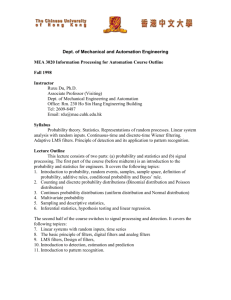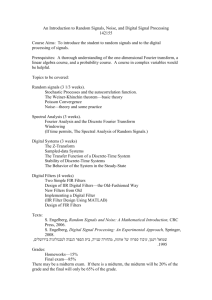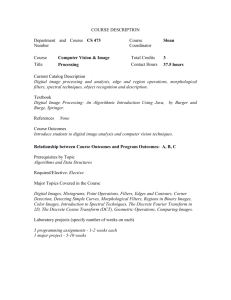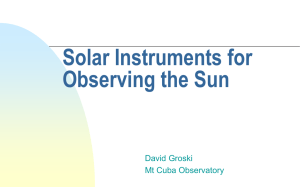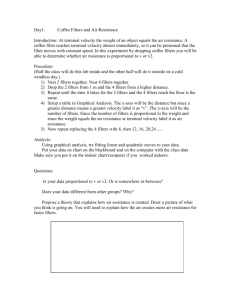EYES SENSITIVE TO GREEN
advertisement
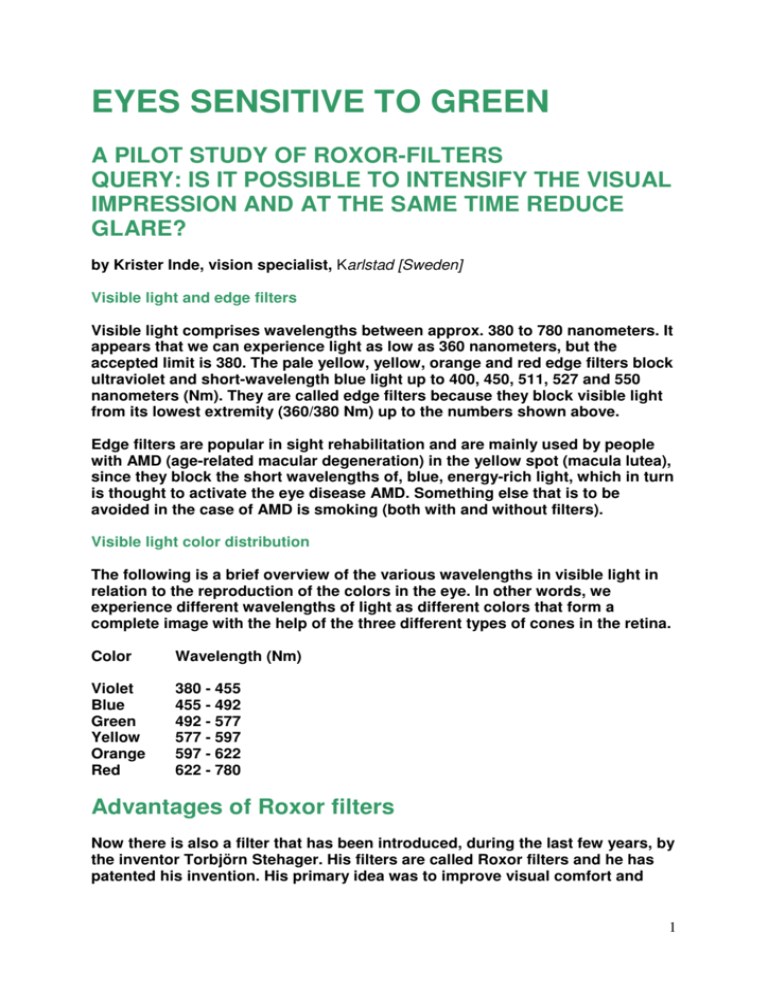
EYES SENSITIVE TO GREEN A PILOT STUDY OF ROXOR-FILTERS QUERY: IS IT POSSIBLE TO INTENSIFY THE VISUAL IMPRESSION AND AT THE SAME TIME REDUCE GLARE? by Krister Inde, vision specialist, Karlstad [Sweden] Visible light and edge filters Visible light comprises wavelengths between approx. 380 to 780 nanometers. It appears that we can experience light as low as 360 nanometers, but the accepted limit is 380. The pale yellow, yellow, orange and red edge filters block ultraviolet and short-wavelength blue light up to 400, 450, 511, 527 and 550 nanometers (Nm). They are called edge filters because they block visible light from its lowest extremity (360/380 Nm) up to the numbers shown above. Edge filters are popular in sight rehabilitation and are mainly used by people with AMD (age-related macular degeneration) in the yellow spot (macula lutea), since they block the short wavelengths of, blue, energy-rich light, which in turn is thought to activate the eye disease AMD. Something else that is to be avoided in the case of AMD is smoking (both with and without filters). Visible light color distribution The following is a brief overview of the various wavelengths in visible light in relation to the reproduction of the colors in the eye. In other words, we experience different wavelengths of light as different colors that form a complete image with the help of the three different types of cones in the retina. Color Wavelength (Nm) Violet Blue Green Yellow Orange Red 380 - 455 455 - 492 492 - 577 577 - 597 597 - 622 622 - 780 Advantages of Roxor filters Now there is also a filter that has been introduced, during the last few years, by the inventor Torbjörn Stehager. His filters are called Roxor filters and he has patented his invention. His primary idea was to improve visual comfort and 1 visual experiences in connection with golf. Many people say that Roxor-filters make it easier to see the white ball amid all the green on a golf course. Roxor-filters suppress green light, between approx. 492 - 577 Nm by 80 % and, hence, the filter tones down the light in a different way from traditional edge filters, that, in principle, block all light from the boundary or the outer edge between invisible and visible light, and upwards. Roxor-filters limit that part of visible light that is green or the eye’s”green dominance”. According to certain theories, the eye has a preference for green things. Perhaps the ballad singer, Barbro Hörberg, was right when she sang her show-piece ”Eyes sensitive to green”? Roxor filters reduce the green range by 80 %, which means that the chlorophyll green mainly disappears but not everything that is green. The color change is not as dramatic as with the edge filters. In other words the idea is that ”you see better” by toning down the green light in ”the image” since the contrast increases and you can see the white golf ball more easily on the golf course. So far, more than 12,000 pairs of Roxor glasses have been sold, so many people must experience improved visual comfort. But what happens, and why does it happen? Roxor – also for people with sight impairment? As a result, we wanted to discover whether Roxor-filters had a role to play in other areas of eyesight care, apart from in the green sports, and what people who have various reasons for their sight impairment thought after using them for some time. Green is experienced as the dominant color in an image, and therefore the other wavelengths in the spectrum are suppressed. In other words, perception is dominated by green and it is difficult to see (golf balls and other white objects) because the green takes over. Do these principles also influence the way in which people with sight impairment experience the image? Would Roxor-filters be able to give them contrast amplification, protection from glare and better sight comfort in other ways too, particularly in strong sunlight, glare, mist etc.? This question is relevant, since Roxor-filters are polarized and in theory also reduce glare from parallel light from shiny surfaces. Roxor-filters’ colors It must be emphasized that the colors in Roxor-filters are neither blue nor purple. They block out blue light to some extent, but they are a complement to edge filters that can block blue light in the eye, entirely or partially. The colors in Roxor-filters are a combination of grey polarization with a hint of magenta. If we are to define the color even more accurately, then it would be more warm plum with a mixture of burgundy, but definitively not blue or lilac blue. The reason for pointing this out is that blue glass lets through just that blue, shortwavelength, energy-rich light, which is said to activate age-related changes in 2 the yellow spot, AMD. There are almost 100,000 colors to take into account and, as a result, it is important to carefully define the filter color and which wave-lengths are released into the lens of the eye and the retina. Roxor is patented and the patent states very precisely which parts of visible light are reduced. Testing Roxor-filters As a vision specialist with long experience of eyesight correction aids and filter glass, it was interesting to let some 20 people test the Roxor-filter with a “fitover” design, so the test sample could put the filters on top of their corrective glasses. I have now been the project manager for a test, in which 19 people with different eye diseases and visual capabilities had to answer a number of questions and say how they experienced the Roxor-filters in different environments after using them for at least one month, and in some cases, up to three months. Do the filters intensify the contrast and tone down glare for people who have different types of eye diseases? We have concentrated on people with various types of retina changes, such as retinitis pigmentosa and glaucoma and, in certain cases, eye media problems, such as cataracts, or after corneal transplantations. These filters might increase sight comfort by influencing the contrast sight or toning down glare without reducing the amount of light in the eye. From a purely ethical point of view, we have taken into consideration the fact that the filters could be contraindicative in the case of progressive macula degeneration. Some people in the test indicated an AMD diagnosis, but then the disease had reached the final stages with visual acuity less than 0.1. The question now is: do these filters offer any actual or subjective sight improvement for people with different types of sight impairment? Are they an obvious aid in eyesight rehabilitation and, if so, which patient groups should they be tested on? I have asked some 10 professionals to select one or two people who wanted to participate in the pilot project and, in the following, I report the patients’ responses. Responses Opticians who tested these glasses on a number of selected patients have said that the patients, in certain cases feel that ”they are comfortable to wear ”. In a few cases, the optician has showed better visual acuity, but also better contrast sight. A brief summary of the answers to the questions, from 19 people who have answered the questionnaire so far after one to three months use, is presented below. Vision impairment 3 AMD 5 Glaucoma 5 RP 5 Cataract 2 Cornea transplant 1 Unknown 1 Of those who have AMD, two have lower visual acuity than 0.1 and the other three can see better. The visual acuity in the group swings between 0.6 and 0.08. There are four people whose visual acuity is less than 0.1, while the remainder are moderately partially sighted or have reduced vision in the range 0.2 – 0.6. All but three people use sunglasses, and, in three cases they are yellow or edge filtered, while the remainder say they use polarized (8) or photochromatic, clip-on glasses, with side protection and ”grey glass”. Those whom one would expect to have visited a Visual Centre tend to have yellow glass (RP and AMD with low visual acuity). What happens when you put on your Roxor-filter? Your first reaction? Here are some responses word for word: ”Pleasant light with no glare. - Blue pink light at first – Different colors – Retains the colors – Feels gentle on the eyes - Comfortable in the car – Green disappeared more – Focus is better perhaps – Dark, the colors change – No glare but more light – Kind to the eyes – Pleasant light - First pink, that disappeared later – Less glare, more light – Everything is clearer, most in daytime watching TV – Nice lens color, good frames on top of own glasses – It got darker” From this we may conclude that impressions differ and are individual. But, something happens for people who want to reduce glare but are nonetheless dependent on light. This particularly applies to people with glaucoma and RP. The person who had just had a cornea transplant was the most positive and stated that both color and focus improved, although this cannot be proved objectively. We also asked if they now wanted to have Roxor, their own sunglasses or both. The answer was that 15 out of 19 wanted to continue to use their Roxor-filters. Only Roxor Both Roxor and own sunglasses Previous sunglasses best No need 8 7 2 2 In other words, there was a general preference to choose the Roxor-filters that they had tested over an extended period. 14 people also wanted to pay a reduced price to keep their Roxor-filters, which can be seen as proof that they 4 were not only well-disposed but also positive to getting ”a pair of their own”. One person reported that Roxor was not at all suitable for her, it gave ”green light” and worse focus and another said that the tinting was too light but that a darker pair might be better. How can we interpret the responses? There is a positive impact for Roxor-filters which means that most people with various kinds of sight impairment feel that ”the picture is improved”, ”glare is reduced without losing out on light” and so on. Others, but this is a minority, do not think that they provide any improvement and that their old sunglasses work. However, there is no doubt that there are sufficient positive signals to justify offering an opportunity to review sight comfort, the experience of better vision, and improvements for people with sight impairment. This primarily applies to people with RP, glaucoma, other cases of people needing light but suffering from glare and AMD in the final stage. Not blocking blue light in the early stages of AMD is of course contradictory, and there Roxor does not do the same job as an edge filter. In some cases the edge filter may also give better contrast than ”the green screen” Roxor, but we do not know before we have tried. We also need to test the glasses for a longer period than a one-off test. Without drawing too many conclusions, Roxor is a good alternative for people who need a lot of light and who have problems with glare, for example in the case of RP, glaucoma with cataracts and for people who are often out in the countryside and have problems in seeing things amid all the greenery. We may also note that a more extensive and more strictly controlled test of Roxor in relation to other filters and transmission-protection glass should be carried out to provide even more objective information. Yet, in this test, we have been able to establish, that 15 out of 18 people would really like to continue to use their Roxor-filters, and we must conclude by noting that everything points to the fact that there is good reason to believe that they make a difference. 5


